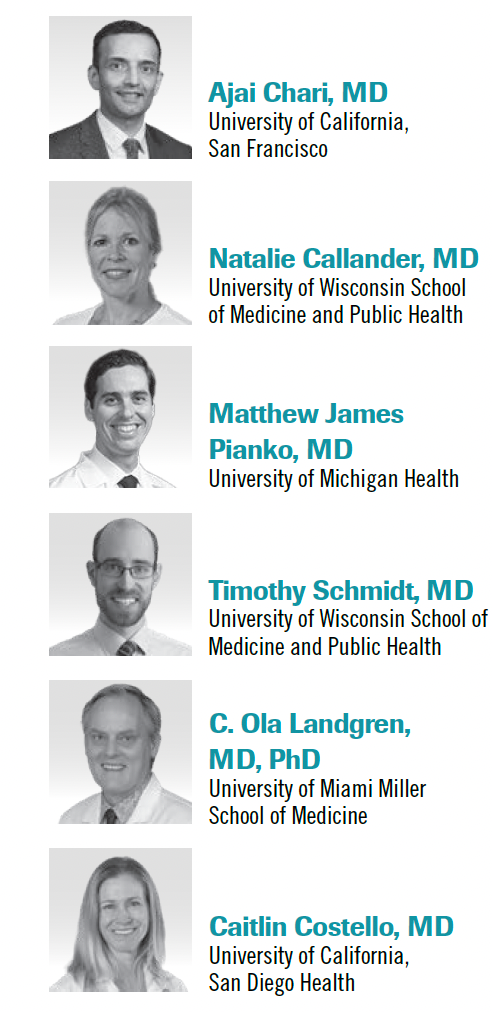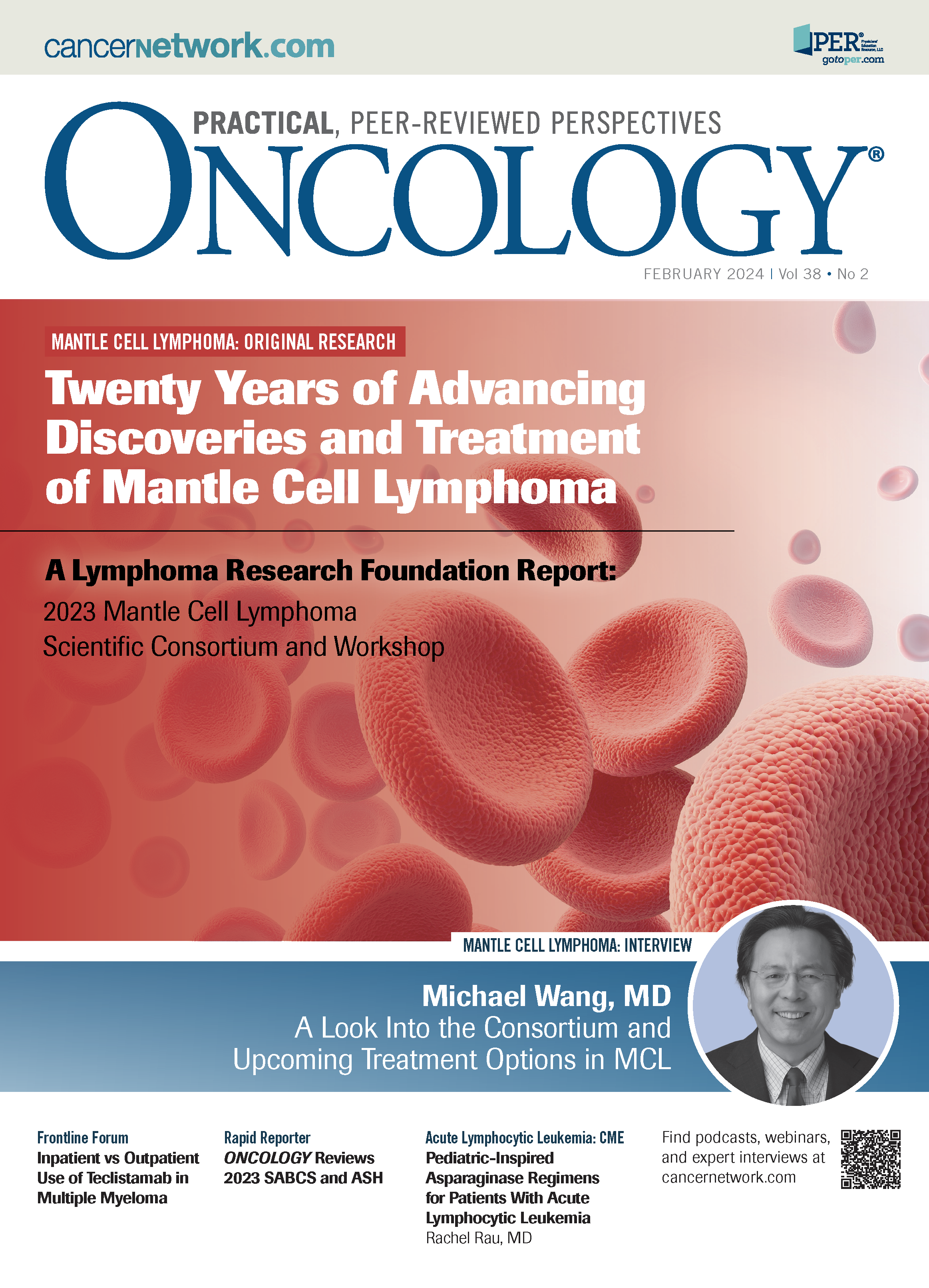Inpatient vs Outpatient Use of Teclistamab in Multiple Myeloma
Experts in multiple myeloma debated the use of teclistamab through an inpatient or outpatient setting.
The panel of experts.

During a Frontline Forum focused on multiple myeloma, experts in the field met to discuss the use of bispecific antibody therapies, treatment sequencing, and current trial updates. The panel discussed teclistamab-cqyv (Tecvayli) and how it has helped lead to evolving treatment paradigms in the space. The group was led by Ajai Chari, MD, professor of medicine at the University of California San Francisco.
Additional panelists include Natalie Callander, MD, director of the University of Wisconsin Carbone Cancer Center Myeloma Clinical Program and faculty member in the Division of Hematology, Medical Oncology and Palliative Care within the Department of Medicine; Matthew James Pianko, MD, clinical assistant professor at University of Michigan Health; Timothy Schmidt, MD, assistant professor at the University of Wisconsin School of Medicine and Public Health; C. Ola Landgren, MD, PhD, professor of medicine, chief of the Division of Myeloma in the Department of Medicine, director of the Sylvester Myeloma Institute, coleader of the Translational and Clinical Oncology Program, and Paul J. DiMare Endowed Chair in Immunotherapy at the University of Miami Miller School of Medicine; and Caitlin Costello, MD, associate professor of medicine at University of California, San Diego Health.
Step-Up Dosing Regimens
To begin the discussion, results from the phase 1/2 MajesTEC-1 trial (NCT03145181; NCT04557098) were presented.1 Top-line findings included 43% of patients achieving a complete response at 22 months. Additionally, at 22 months, the median duration of response was 24 months, the median progression-free survival was 12.5 months, and the median overall survival was 21.9 months.
During week 1 of treatment, patients were given 0.06 mg/kg and 0.3 mg/kg of teclistamab. During cycles 1 and onward, weekly teclistamab was given subcutaneously at 1.5 mg/kg and continued until progressive disease.
Hematologic adverse effects (AEs) were of grades 3 and 4 and included
neutropenia (72% vs 65%), anemia (54% vs 38%), and thrombocytopenia (42% vs 22%), respectively. A total of 72% of patients experienced infections and cytokine release syndrome (CRS), respectively. One patient in phase 1 experienced a dose reduction due to neutropenia. Currently, 49 patients remain on the study and approximately 90% have received dosing of once every 2 weeks.
Chari posed the question to his colleagues, wanting to know how the results from this trial changed their practice. Callander noted it has dramatically affected how she treats patients, with Landgren chiming in that he foresees this being an outpatient procedure in the future.
Often there is a lag time between a drug being approved and clinicians being allowed to use it in the clinic. For Callander, she began to use it almost immediately; however, Pianko had to wait approximately 2 months to gain access to the treatment, which was still relatively quick.
“These products, because of their highly active nature and the nature of the population who needs it, at most academic institutions, the time from approval to getting it to your patient was unprecedentedly short because of the dire need of these patients,” said Pianko.
At Costello’s institution, she noted some logistics needed to be worked out, specifically how to manage AEs and the increased need for hospital beds. Despite these challenges, Schmidt noted how important it was that this treatment was available for patients and how clinicians worked so hard to make it available.
While the clinicians have adjusted to the logistics of administering teclistamab, Chari wanted to know how step-up dosing was tackled. Pianko monitors patients for 48 hours and tries to shorten the step-up dosing schedule because it helps to limit inpatient time because of resource limitations. This hardship is not something institution specific but occurs at centers across the country.
“We took a very similar approach at our institution. I think I went to the formulary committee the day after the approval, and we had it up and going about a month later. We had read the fine print very carefully, and it said, as we know, 2 days apart, but there was a footnote saying that at the discretion of the clinician, it could be only 1 day apart. We made up the default rule, did day 1, day 3, and day 5,” said Landgren.
As is common with a bispecific antibody, patients often experience CRS. Often tocilizumab (Actemra) will be given to help mitigate the effects, but typically only when it hits grade 2. Clinicians are finding that administering it during grade 1 after treatment with teclistamab has helped lessen the CRS experience.
Callander and Pianko don’t use early tocilizumab because of pushback from the pharmacy and being conservative with cost. Landgren’s institution uses tocilizumab as a prophylactic medication, as it was approved internally to do so. Landgren presented these findings at the 2023 American Society of Hematology (ASH) Annual Meeting & Exposition.2
Costello asked the panel where they are admitting these patients when AEs occur. She’s begun admitting patients to the cellular therapy and transplant services, which causes issues with bed space. Landgren admits his patients to the myeloma inpatient service but cautions that clinicians should be aware of and able to manage the AEs that occur.
Bispecific Education
The conversation switched to how bispecifics are originally administered at an institution, specifically in those without experience with chimeric antigen receptor (CAR) T-cell therapy. Costello said her institution made sure all nurses in the clinic and inpatient centers were educated on AEs. Additionally, it would be helpful if the institution had a cellular therapy background or education. Patients also need to be educated on what to expect and when to contact the clinic.
In the bispecific space, the clinicians agreed that they have seen very little CRS and immune effector cell—associated neurotoxicity syndrome (ICANS). Landgren, who uses tocilizumab prophylactically, has seen very few cases of CRS but has seen moreICANS. However, he brings up the point that it can be hard to differentiate the 2 syndromes because of the occurrence of an AE and the ability to detect it.
Teclistamab Use in the Outpatient Setting
A study recently presented at ASH highlighted the use of teclistamab in an outpatient setting when step-up dosing was administered.3 Of the 39 patients who received a dose of teclistamab, 37 were given step-up dosing. Of those, 32% developed CRS, and all were admitted to the hospital with a median stay of 1.7 days. Of note, only 1 patient experienced ICANS.
Chari asked how the group practices admissions, and everyone answered inpatient, except for Costello, who utilizes outpatient treatment with parameters. Landgren and Pianko noted that there are plans to switch to outpatient soon.
Some conditions for outpatient treatment that Costello outlined included having caregiver support, close proximity to the treatment center, and vital monitoring systems. “There's cool options that are happening out there where people are wearing monitors that can be transmitted to a third party that can call the on-call doctor if there's changes,” she said.
Callander said her hospital is pushing back on the idea of outpatient treatment with teclistamab because of the bed capacity. Typically, they are at 98% and 99% capacity, so if severe AEs are being experienced, they may not have enough room for these patients to be admitted. She also highlighted other institutions are beginning to have dedicated oncology doctors in the emergency department (ED), which she hopes to be able to have in the future.
Chari asked Costello what the triage process is like for patients experiencing AEs at home. She said that the University of California, San Diego Health, does have these same challenges. Those in the ED must be educated on how to handle these AEs, electronic health records must be set up to highlight that this patient is receiving immunotherapy, and an on-call oncologist should be notified immediately.
Another ASH presentation looked at step-up dosing of teclistamab using real-world data and all-payer claims. At the data cutoff, 99 patients had completed step-up dosing, with 87.9% completing step-up dosing in 1 inpatient admission, 4.0% fully outpatient, and 8.1% in hybrid inpatient/outpatient settings.
For patients who had more than 1 hospitalization due to teclistamab, the median length of stay was 8.0 days, and the mean was 8.3 days. The mean length of step-up dosing shortened from 12.1 to 1.2 days.
Based on these data, Callander said she would not feel comfortable giving a bispecific as an outpatient treatment because “[patients are] too debilitated from their disease, and they have too many end-organ issues.”
Schmidt chimed in, saying it’s important to look at the patient’s comorbidities and determine whether cytotoxic chemotherapy and its rapid response have more pros than using a bispecific. Landgren disagreed, saying he’d give it to all his patients because there is no restriction for age or any other traditional factors.
FDA Decisions and Weighing In on Treatment Factors
In a statement in November 2023, the FDA brought forth that there was potential for T-cell malignancies to develop after treatment with B-cell maturation antigens or CD19-directed CAR T-cell therapies.4 The panel noted that there were very few cases identified and stood by the FDA’s position that the potential benefits would outweigh the risks of treatment.
“[The FDA] reviewed about 600 cases, of which there was only 1 patient with a T-cell malignancy, and that patient had T-cell abnormalities prior to the apheresis. It goes back to what [we discussed]; there’s always patient disease and treatment factors, and if these are just heavily treated patients, that’s not the treatment-related issue,” said Pianko.
References
- Moreau P, Garfall AL, van de Donk NWCJ, et al. Teclistamab in relapsed or refractory multiple myeloma.
N Engl J Med. 2022;387(6):495-505. doi:10.1056/NEJMoa2203478 - Kowalski A, Lykon JL, Diamond B, et al. Tocilizumab prophylaxis for patients treated with teclistamab: a single-center experience. Blood. 2023;142(suppl 1):4709. doi.10.1182/blood-2023-187086
- Sandahl TB, Soefje SA, Calay ES, et al. Real-world treatment outcomes of teclistamab under an outpatient model for step-up dosing administration. Blood. 2023;142(suppl 1):5154. doi.10.1182/blood-2023-174270
- FDA investigating serious risk of T-cell malignancy following BCMA-directed or CD19-directed autologous chimeric antigen receptor (CAR) T cell immunotherapies. FDA. November 28, 2023. Accessed January 10, 2024.https://bit.ly/47CkPYY
EP: 1.Overview of NRG1 Fusions
EP: 2.NRG1 Fusion Testing Practices
EP: 3.Recent Data on Zenocutuzumab at ESMO 2023
EP: 4.Practical Considerations for Zenocutuzumab in NRG1 Fusion–Positive Malignancies
EP: 5.Clinical Pearls on Treating Patients with NRG1 Fusions
EP: 6.NRG1 Fusions in Lung and GI Cancers
EP: 7.Testing for NRG1 Fusions
EP: 8.Clinical Diagnosis of NRG1 Fusions in NSCLC
EP: 9.Ongoing Research of NRG1-Targeted Therapies
EP: 10.NRG1 Fusions in Pancreatic Cancer and Potential Role of Zenocutuzumab
EP: 11.Key Takeaways for the Treatment of NRG1 Fusion–Positive Malignancies
EP: 12.Defining a Space for NRG1 Fusion–Positive Tumors in Lung and GI Cancers
EP: 13.Inpatient vs Outpatient Use of Teclistamab in Multiple Myeloma

Relapsed/Refractory Multiple Myeloma Trial Updates From ASCO 2023
August 7th 2023Experts from Mayo Clinic and The University of Texas MD Anderson Cancer Center discuss results from multiple myeloma trials presented at the 2023 American Society of Clinical Oncology Annual Meeting and how they may apply to clinical practice.